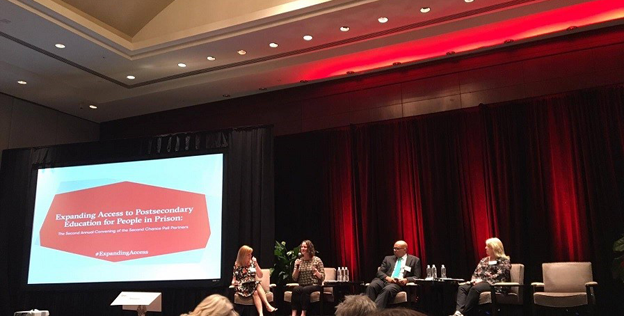Tips on Securing Funding for Correctional Education Programs
October 11, 2017

For individuals involved with the justice-system, postsecondary education and training is a chance to develop skills and training necessary to get a job upon release.
Having a degree or credential, not only improves employment outcomes, but also reduces the likelihood that an individual will recidivate, or return to jail or prison by 43 percent.
Despite the evidence of benefits, most justice-involved individuals do not have an education beyond high school. In fact, only 11 percent and 24 percent of incarcerated individuals in state and in federal corrections systems, respectively, have completed at least some type of postsecondary education.
That is why in July 2016, the U.S. Department of Education launched the Second Chance Pell pilot program, expanding Pell Grant eligibility to 12,000 incarcerated individuals annually. Funding for the pilot program covers tuition, fees, books and supplies and are issued directly to postsecondary institutions, mostly community and technical colleges that deliver education and training in more than 100 state and federal prisons.
Last week, representatives from educational and correction institutions participating in the project flew to Houston for a day-long convening hosted by The Vera Institute of Justice ("Vera"), a nonprofit organization selected by the U.S. Department of Justice, Bureau of Justice Assistance to provide one year of technical assistance to Second Chance Pell pilot sites and partners.
Jennifer Zeisler, ECMC Foundation's career readiness program director, presented in one of the event's plenaries, "Strategies for Funding College-Prison Partnership." Zeisler joined panelists representing federal and state agencies to offer tips for those seeking funding for correctional education programs.
JENNIFER ZEISLER, ECMC FOUNDATION ON SECURING PRIVATE FOUNDATION FUNDING
- Come prepared: It is important to "have all your ducks in a row" before meeting with a funder, Jennifer said. "The strongest grantees have a clear understanding of their proposed project. They are able to provide program data and they have their organizations' financial information available."
- Know your Audience: "Get to know the funder and how your work aligns with their goals and objectives," she said. Understanding the funder's interests is important. For instance, recidivism is an important measure for most criminal justice organizations and programs, but is not the focus of some funders like ECMC Foundation, which prioritizes educational outcomes.
- Use Data and Storytelling: When sharing information about your program, use a "mix of data and storytelling. Use data to talk about your work and find champions who can bring the stories to life."
- Get Your Name Out There: Publicity is important. Jennifer says her team has found some of their grantee partners through reading about their successes in news clips. Getting media coverage "helps to legitimize your work."
- Think Broadly: Organizations can fall into the trap of only looking for funders that work solely in a specific area. Jennifer says it's important to "think broadly." Like ECMC Foundation, other funders may not specifically focus on the needs of the justice-involved community, but they may have a commitment to the location, population, or programmatic work being done by your organization. "I think the best way to get started is to identify your peers – again, broadly defined – and find out who funds their work."
TIPS FROM OTHER PANELISTS
Other panelists included Sean Addie from the U.S. Department of Education and Marcie Koetke from the Minnesota Department of Corrections.
- Expand Funding Streams: Koetke worked at the Minnesota corrections agency when state and federal correctional agencies were first barred from accessing Pell Grant in the early-nineties. She says looking into different funding streams allowed her agency to continue delivering educational programs. "Diversify your funding," said Koetke.
- Consider Other Funding Streams: Addie made suggestions for additional federal funding streams that correctional agencies and colleges could potentially tap into: Second Chance Act, Workforce Innovation and Opportunity Act, Carl Perkins Vocational and Technical Education Act. He also reassured the crowd that the project pilot program will continue to be funded. "Second Chance Pell experimental sites will still go on," he said.
- Secure Partnerships: Koetke cited partnerships, including those with funders, as the key to success in running their educational programs. "Stay in touch and make decisions together."
ECMC Foundation's Jennifer Zeisler was invited by Vera to speak at the plenary. As the program director of the Foundation's Career Readiness portfolio, she oversees investments that provide support to accredited, industry-informed, postsecondary career and technical education programs for adults, including currently and formerly incarcerated individuals.
